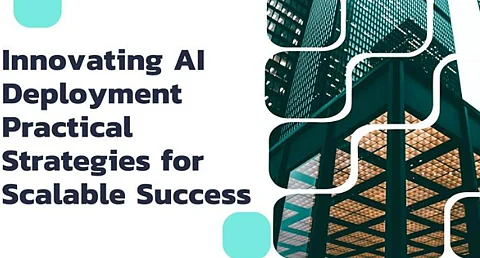

Artificial intelligence has transformed industries, yet many organizations struggle to transition AI solutions from prototypes to fully operational systems. Danish Khan, a prominent figure in AI research, explores this critical challenge in his latest work, offering practical strategies for successful AI deployment. This article delves into key innovations that enhance AI scalability, ensuring long-term performance and efficiency.
At the center of any AI deployment is data engineering, which ensures that systems remain stable and scalable. Very mature organizations that set up structured data pipeline architectures sharply cut deployment times and improve the quality of the data. In most cases, advanced data validation frameworks can detect anomalies with high precision so that the likelihood of AI faulty predictions is minimized. Automated monitoring systems act as a fail-safe solution against applications being down by collecting back-end logs and metrics to pinpoint errors even before they affect production, thus ensuring steady data flow and operating efficiency.
Real-time data integration allows AI systems to ingest new information and keep the model contemporary in dynamic conditions. Data lineage tracking brings a great deal of transparency that aids in meeting regulatory compliance requirements and troubleshooting in complex scenarios. Containerized data processing workflows utilize resources with high efficiency by providing predictability against varying computing landscapes. Distributed processing frameworks seamlessly oversee voluminous data influxes while guaranteeing undistracted response times from the systems.
Cloud computing has become a game-changer in AI scalability. By leveraging cloud-native technologies, organizations benefit from cost reductions and faster deployment cycles. Containerized AI workloads, managed through orchestration platforms, enhance resource utilization and enable dynamic scaling. Infrastructure as Code (IaC) has revolutionized environment provisioning, reducing configuration errors and ensuring consistency across multiple deployment stages. With auto-scaling mechanisms, businesses can efficiently handle fluctuating workloads while maintaining optimal system performance.
Deploying AI models is just the beginning—maintaining their performance in production is a continuous challenge. Effective monitoring frameworks track various performance metrics, allowing teams to identify potential degradation early. Automated model retraining pipelines ensure AI systems adapt to evolving data patterns, preventing accuracy declines. Version control systems further enhance stability by managing multiple iterations of AI models, reducing deployment risks, and allowing seamless rollbacks if necessary.
Comprehensive data drift detection mechanisms alert teams to shifts in input distributions that could impact model performance. Regular stakeholder feedback loops provide qualitative insights that complement quantitative metrics, offering a holistic view of system effectiveness. Implementing A/B testing frameworks enables controlled experimentation with model improvements before full deployment. Establishing cross-functional review processes ensures technical optimizations align with business objectives and end-user needs. Documentation of model behaviors across different scenarios creates valuable institutional knowledge that streamlines future troubleshooting and enhancement efforts.
One of the critical barriers to effective AI deployment is the gap between academic training and real-world implementation. Many graduates lack practical experience in deploying AI systems, creating a skill shortage in the industry. Hands-on projects, industry-aligned curricula, and DevOps training can significantly improve workforce readiness. Organizations that integrate structured training programs see higher success rates in AI implementation, as professionals gain exposure to real-world deployment challenges.
Mentorship programs connecting students with industry practitioners provide valuable insights into operational complexities not covered in traditional coursework. Collaborative research partnerships between universities and corporations facilitate knowledge transfer and create innovation pipelines. Simulation environments that replicate production challenges help develop troubleshooting abilities and system integration skills. Continuous professional development opportunities addressing emerging technologies and methodologies ensure practitioners remain current with rapidly evolving best practices and tools.
Every successful deployment of AI involves solid methodologies that concern the elements of high-quality data and scalability along with continuous observation. The scaling process beginning at a pilot level deployment again becomes a good way for an organization to ruminate about the data validation techniques before going at it whole hog. Documentation is well kept and encourages the sharing of knowledge, thereby improving system reliability and shortening downtime in troubleshooting. Proactive crisis management frameworks, including an automated rollback or backup system, ensure maximum resilience in production environments.
Cross-functional collaboration between technical teams and business stakeholders ensure alignment with organizational goals throughout the deployment lifecycle. This will also include comprehensive security protocols and ethical guidelines to prevent illegal access to sensitive data and the issues associated with regulatory compliance. Analysis of performance every once in a while, coupled with feedback from users, will create avenues for iteration. By investing in training employee programs, this internal capacity can be developed rather than relying heavily on external consultants. Clear success metrics, indeed related to business outcomes, can establish quantifiable indications of the effects of AI on efficiency as well as return on investment regarding operational costs.
In conclusion, As AI is continuously evolving, structured approaches to deployment remain a prerequisite for scaling and sustainable implementation. Danish Khan would rather insist that "strong data engineering principles coupled with cloud solution frameworks and rigorous monitoring provide the essentials for deploying scalable systems, sustainable implementations, and intelligence." Organizations using best practices and closing the academia-industry gap will successfully migrate AI models from development to enterprise-scale production to realize their full potential in the digital world.
